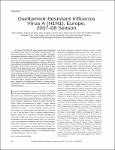Oseltamivir-Resistant Influenza Virus A (H1N1), Europe, 2007–08 Season
Meijer, Adam
Lackenby, Angie
Hungnes, Olav
Lina, Bruno
Werf, Sylvie van der
Schweiger, Brunhilde
Opp, Matthias
Paget, John
Kassteele, Jan van de
Hay, Alan
Zambon, Maria
Buchholz, Udo
Haas, Walter
In Europe, the 2007-08 winter season was dominated by influenza virus A (H1N1) circulation through week 7, followed by influenza B virus from week 8 onward. Oseltamivir-resistant influenza viruses A (H1N1) (ORVs) with H275Y mutation in the neuraminidase emerged independently of drug use. By country, the proportion of ORVs ranged from 0% to 68%, with the highest proportion in Norway. The average weighted prevalence of ORVs across Europe increased gradually over time, from near 0 in week 40 of 2007 to 56% in week 19 of 2008 (mean 20%). Neuraminidase genes of ORVs possessing the H275Y substitution formed a homogeneous subgroup closely related to, but distinguishable from, those of oseltamivir-sensitive influenza viruses A (H1N1). Minor variants of ORVs emerged independently, indicating multiclonal ORVs. Overall, the clinical effect of ORVs in Europe, measured by influenza-like illness or acute respiratory infection, was unremarkable and consistent with normal seasonal activity.
No license information

